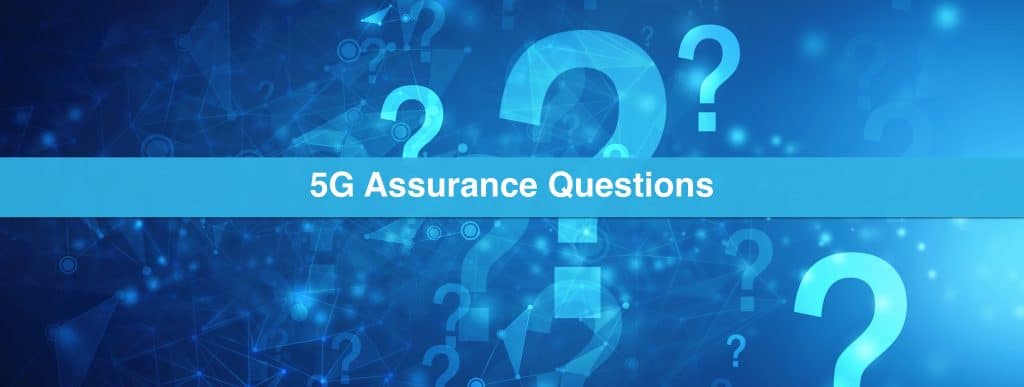5G and all that it promises ushers in a more wireless world where we are always connected, and the services we need are always available on-demand. Tasks that usually take minutes can be accomplished in a matter of seconds with blistering upload, download, and streaming speeds. This will change the way we live, work, and communicate.
These services will be delivered using a new 5G core built on a cloud-native architecture, with Multi-access Edge Computing (MEC) and network slicing to enable the performance, latency, and quality of experience expected from 5G networks. The shift towards the new network architecture is a seismic transformation. Still, it brings opportunities for operational flexibility and scalability, laying the foundation for the next generation of dynamic services.
In part 3 of the Ask the 5G Expert series, this blog will address the use of AI and machine learning (ML) in the era of 5G and why it’s critical for them to be integrated into an assurance solution.
1. Using AI and ML for service assurance isn’t new, but I believe this will be critical for 5G. Why is that?
One of the central promises of 5G is an improved customer and service experience, which must be delivered alongside one of the main challenges facing operators in 5G, managing the significant increase in data traffic and devices. It is estimated that by 2023 there will be 29.3 billion connected devices globally. That is an increase of nearly 10 billion devices on the current global figures, which stands around 20 billion.
Network traffic growth is driven by the rising number of smartphone subscriptions and increasing average data consumption per subscriber. For an operator having to pinpoint service degradations, which may affect the customer experience among the billions of connections running through the network, is like finding a needle in a haystack.
It is clear that for 5G, the traditional telecom network operations and management model will not meet the increasing requirements needed and ensure a smooth transition to 5G; operators require a more intelligent and automated network. Additionally, operators need to address the challenge of Massive Machine-Type Communications (mMTC), which provides connections to large numbers of devices that intermittently transmit small amounts of traffic.
IoT in 5G will cover a broad spectrum of use cases and applications. From smart metering and asset management that require significant numbers of low-cost devices to send small amounts of data, to drones and VR/AR applications that have high throughput, low latency, and large data volumes. In the future, use cases will expand to include autonomous cars and traffic safety that require ultra-low latency, ultra-reliability, and high availability as well as smart electrical grid automation and industrial automation that are time sensitive and require precise positioning.
With 5G networks being able to support one million device connections per square kilometer, operators need to be proactive and assure connectivity, safeguard the security, and manage IoT service complexity at scale. IoT devices will not report if they are having a problem connecting to the network; therefore, robust anomaly detection is essential. Operators must consequently deploy advanced technologies in AI and ML for a smarter, more efficient network able to pinpoint the network degradations or connection failures as soon as they occur. Introducing intelligence into the network with AI-driven service assurance will be essential for network operations, verification, and optimization in 5G.
AI and ML empowered solutions allow the operator to analyze the massive amount of data generated by the network, which no human can do. In turn, this will also help to free up resources and engineers’ time to handle issues relating to 5G by automating legacy network monitoring. Using AI operators can analyze the data and find patterns and relationships in the data. Using this information, the operator can set Key Performance Indicators (KPIs) and thresholds for service delivery. When an anomaly occurs, or the service drops below the predefined threshold, an alarm will trigger, alerting the operator of the issue.
Embedding this technology into a service assurance solution will therefore be critical in 5G because it allows machines to do what they do best, i.e., recognize patterns and allows the engineers, who in any case would not be able to analyze these quantities of data, to focus on handling critical issues which require human intervention. Operators need to know that their service assurance solution is monitoring the entirety of the network and catching issues in real-time. This is only possible with the use of AI and ML.
2. Why should AI and ML be built-into the assurance solution in 5G?
The simple answer to this question is data, as the secret to AI and ML is also data. In 5G, operators will need to deploy automated, probe-based assurance solutions to monitor the customer experience and troubleshooting the network at both a macro and micro level. The data collected by these solutions can be fed into the built-in AI and ML models to analyze and highlight anomalies in the data and service. Having built-in KPI anomaly detection offers several benefits to the operator. It can combine data that has been collected for assurance purposes. AI is then applied to all of the data collected, and not just a subset, making the overall solution smarter. This helps to save on unnecessary expenses for an additional solution, such as data storage costs. Service Assurance with built-in AI also helps save time massaging the data for external processing, and it runs on any data set. For example, to analyze user plane KPIs such as user throughput and latency, and then switch to evaluation release, cause errors automatically.
By utilizing built-in AI and ML, operators can move to automate their network operations by triggering alarms when the assurance solution detects the service level drops below a predefined threshold. AI will be an essential building block for automating network operators and facilitating an open/ closed-loop approach to assurance. For use cases like dynamic network slicing and predictive analytics, AI, and ML will be essential for identifying traffic patterns and trends which create rules and policies that proactively prevent and resolve issues. These insights provided by AI-driven service assurance will feed into the operators’ orchestration to enable open/closed-loop control, which saves on OPEX and ensures the network quality automatically, which will be vital to delivering high quality, personalized services in the 5G era.
Finally, as encryption is becoming the default in 5G, operators are left in a blind spot concerning their users’ Quality of Experience (QoE). AI and ML will be a critical enabler in gaining insights into encrypted traffic. 5G promises many complex use cases, including super-fast download speeds, tethering, and gaming, all of which required sustained low latency and high throughput. For an operator to know if they are delivering these standards, they need to understand how their network functions. For example, for video streaming the assurance solution can gather data on specific metrics alongside a crawler, which calculates KQIs. The assurance solution can then apply advanced tools in AI and ML to analyze thousands of these samples, fine-tune the KPIs and enable anomaly detection in the traffic patterns, even if they are encrypted. Without built-in AI and ML capabilities, the operator would not know the true service experience for encrypted traffic, and therefore it must be incorporated into the service assurance solution.
Expert conclusions
5G promises a lot, but each promise comes with its own set of challenges. One way to overcome some of these challenges will be to deploy an advanced service assurance solution with built-in AI and ML capabilities. This will help the operator effectively and automatically monitor the network in its entirety, handing vast quantities of data and detecting anomalies in near real-time. Ultimately the goal is to deliver an improved customer experience. With AI and ML in 5G, operators know that their service assurance solution will proactively detect and resolve issues in the network before customers are even aware of them.
If you have a 5G assurance question you would like our experts to answer please submit it here
This blog post may contain forward-looking statements within the meaning of the Private Securities Litigation Reform Act of 1995. To read more about forward-looking statements, please click here.


